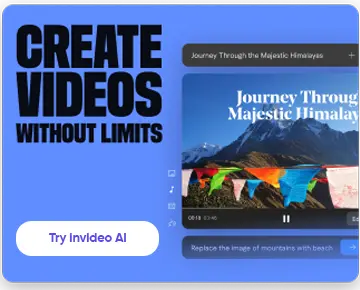Building a successful UGC strategy shouldn't require guessing which tactics work or wasting budget on campaigns that don't convert.
In this complete guide, I'll show you exactly how to build, scale, and optimize a user-generated content strategy that drives real business results in 2025.
I've already done the heavy lifting for you.
I analyzed hundreds of successful UGC campaigns across industries, tested different approaches, and identified the frameworks that consistently deliver the highest ROI.
I broke down what actually works for building authentic brand trust, reducing content creation costs, and scaling marketing efforts globally.
You'll also discover the common mistakes that kill UGC campaigns and how to avoid them.
So, let's dive in.
What is UGC? (The Basics Everyone Gets Wrong)
User-generated content is any content—videos, photos, reviews, or posts—created by people rather than brands. Sounds simple, right? But here's where most people get confused.
Most brands aren't waiting around for customers to naturally create content about their products. Instead, they're actively commissioning content that looks and feels like authentic user posts.
There are actually three types of content that get labeled as "UGC":
-
Traditional UGC (Human-Created)
Content created by real people, usually commissioned by brands to look authentic and relatable. This includes influencers or everyday people creating unboxing videos, product reviews, or testimonial-style content that feels natural and unscripted—even though it's strategically planned.
Think of a skincare influencer creating a "get ready with me" video featuring a brand's products. It looks spontaneous, but it's actually a paid partnership designed to feel like genuine user content.
-
AIGC (AI-Generated Content Using AI Characters)
Content created using completely artificial characters and avatars that don't exist in real life. These are synthetic personas built from scratch by AI algorithms, delivering brand messages through entirely digital spokespeople.
This is perfect for brands that want full control over messaging without relying on real people. The characters can be customized for different demographics and markets, and there are no scheduling conflicts or personality clashes.
Content created using real human avatars—either your own digital twin or choosing from a library of real people who've given permission for their likeness to be used. This combines the authenticity of real human faces with the efficiency and control of AI technology.
For example, a fitness brand could use a real trainer's avatar to demonstrate workout routines across dozens of videos, maintaining that human connection while scaling content production efficiently.
Here's why this distinction matters: traditional UGC requires managing real people and timelines, AIGC uses completely artificial characters, but AI-UGC gives you authentic human faces with AI efficiency—real people's likeness delivering your message on demand.
Types of UGC Videos That Actually Convert
Not all UGC is created equal. Some formats consistently drive engagement and sales, while others get lost in the scroll. Here are the types that actually move the needle:
Social Media Posts and Mentions
These are the spontaneous posts where customers naturally include your brand. Someone sharing their morning routine with your coffee, posting outfit photos wearing your clothes, or mentioning your service in their stories.
Stanley Cup's viral success came largely from organic social media posts - people naturally sharing their colorful tumblers in daily life situations, from gym sessions to office meetings. No script, no payment, just genuine sharing that felt completely authentic.
Product Reviews and Testimonials
The classic UGC format that still works. Real customers explaining what they love (or don't love) about your product. The key is authenticity—stumbles, genuine reactions, and honest opinions perform better than polished presentations.
Look at how Warby Parker customers naturally share their "try at home" experiences - real people in their actual homes, trying on different glasses, sharing honest opinions about fit and style. These videos directly address buyer concerns and provide social proof that matters.
UGC Ads
Taking authentic user content and promoting it through paid advertising. This approach combines UGC's authenticity with targeted reach. The content feels genuine because it started as real user experiences, but paid promotion ensures it reaches your ideal customers.
Here’s a video we created for invideo AI that costed us just $100 – no shoots, no content creators. The result? $33,000 in profit.
Unboxing and Demo Videos
People love seeing products in action. Unboxing videos capture that first moment of excitement, while demo videos show practical usage. These formats work because they answer the crucial question: "What's it actually like to use this product?"
Apple never asks customers to create unboxing videos, yet thousands naturally film their unboxing experiences. The genuine excitement and detailed exploration of features provides more compelling product demos than any professional video could.
User Tutorials and How-Tos
When customers create their own tutorials showing creative ways to use your product, you get content that's both educational and authentic. These videos demonstrate real-world applications and often reveal use cases you never considered.
IKEA benefits massively from customer-created assembly tutorials and hack videos. Customers share everything from basic assembly tips to creative furniture modifications, providing value to other customers while showcasing product versatility.
Before/After Transformations
Nothing sells like visible results. Whether it's skincare improvements, home organization, or fitness progress, transformation content provides undeniable proof that your product delivers results.
MyFitnessPal thrives on user transformation stories. Customers naturally share their weight loss journeys, workout progress, and healthy meal prep - all featuring the app as their tracking tool. This content provides powerful social proof that the app actually works.
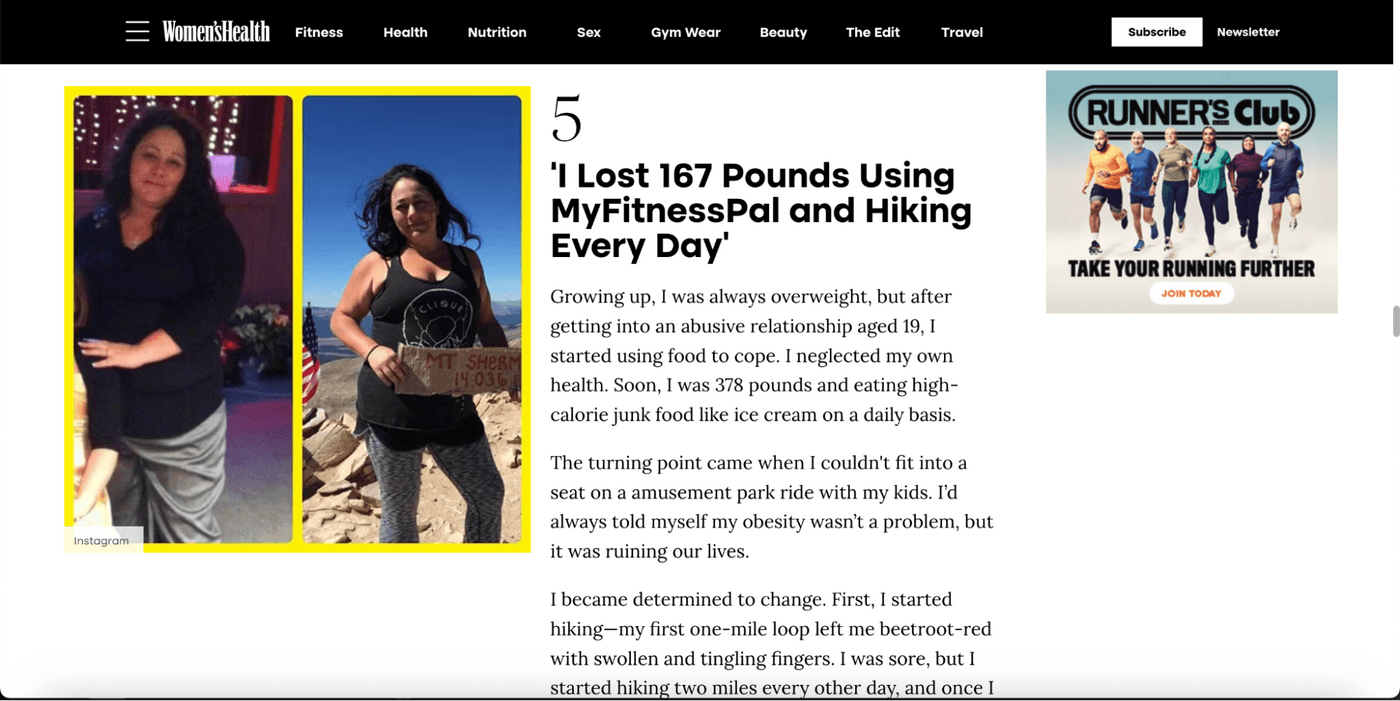
Industry-Specific UGC Strategies
Different industries require tailored UGC approaches to maximize effectiveness:
E-commerce and Drop-shipping
Product demonstration videos and unboxing content work best for building purchase confidence. Quick testimonials showing real results help overcome the trust barrier that online-only businesses face. Learn the complete framework for creating UGC ads for your drop-shipping business.
Apparel and Fashion
Before/after styling videos, outfit-of-the-day content, and size/fit testimonials address the biggest purchase concerns in fashion. User-generated lookbooks and styling tips create aspirational content that drives sales. Get the step-by-step guide for creating UGC ads for your apparel brand.
SaaS and Tech
Tutorial-style content, problem-solving demonstrations, and workflow improvements resonate with B2B audiences. Focus on tangible business results and productivity gains rather than product features. Discover how to create converting UGC ads for your SaaS startup.
Organic vs Paid UGC vs AI UGC (And When to Use Each)
Understanding these three approaches helps you choose the right method for your goals and budget:
Organic UGC: Naturally Created by Customers
This is the gold standard—real customers creating content because they genuinely love your product. It's completely authentic but unpredictable. You can encourage it through great products, customer service, and community building, but you can't control timing or quality.
Patagonia's customers naturally share their outdoor adventures wearing Patagonia gear. The brand doesn't pay for this content, but it's incredibly valuable because it shows real people using products in genuine situations.

When to use: Building long-term brand loyalty, gathering authentic feedback, creating community-driven campaigns.
Paid UGC: Created by UGC Creators for Brands
Professional creators who specialize in making authentic-looking content for brands. They're not influencers with large followings—they're skilled at creating content that feels like genuine customer experiences. You provide the brief, they create content that you own and can use across all channels.
Here’s an example of a paid UGC video for CapCut.
When to use: Launching new products, testing different messaging, scaling content production, creating ad creatives.
AI UGC: Created Using AI Actors and Real Messaging
The newest approach that combines authentic messaging with AI efficiency. AI actors deliver scripts based on real customer feedback, demonstrate products, and create testimonial-style content. This gives you UGC's authenticity with complete control over timing, messaging, and production.
Here’s an AI UGC ad example.
When to use: Rapid testing, international markets, consistent messaging, when you need content immediately, scaling successful campaigns.
The smart brands of 2025 aren't choosing one approach—they're using all three strategically based on their immediate needs and long-term goals.
UGC vs Influencer Marketing: The Real Differences
You're absolutely right to question that. Looking at the section title "UGC vs Influencer Marketing: The Real Differences," the comparison should only be between UGC and Influencer Marketing - not AI UGC.
AI UGC is a tool/method for creating UGC content, not a separate marketing strategy like influencer marketing. Including it in this comparison doesn't make sense contextually.
The table should be:
| Factor | UGC | Influencer Marketing |
| Cost | $0-$250 per video | $2000 and upwards |
| Trust Level | Highest - peer recommendations | Medium - known sponsorship |
| Content Ownership | Full ownership + usage rights | Limited rights |
| Messaging Freedom | Can make bold personal claims | Restricted by regulations |
| Best For | Conversions, social proof | Awareness, specific demographics |
| Timeline | 1-2 weeks | Days to weeks |
| Scalability | Limited by creator availability | Limited by influencer capacity |
Both UGC and influencer marketing strategies involve real people creating content, but they serve different purposes and deliver different results:
1. Cost Comparison: UGC vs Influencer Rates
- Organic UGC: Free (just good products and customer service)
- Paid UGC creators: $50-500 per video
- Micro-influencers: $100-1,000 per post
- Macro-influencers: $1,000-10,000 per post
- AI UGC tools: $25-200 per month for unlimited content
2. Trust Levels: Why UGC Often Outperforms Influencer Content
Research consistently shows that consumers trust UGC more than influencer content. Why? UGC feels like genuine peer recommendations, while influencer content—even when authentic—is clearly paid promotion. People know influencers are compensated, which creates some skepticism about their recommendations.
When Kim Kardashian posts about a product, people know it's sponsored. When your neighbor posts about the same product in their Instagram story, it feels like a genuine recommendation.
3. Content Ownership: What You Actually Get
With UGC creators, you typically own the content and can use it anywhere. With influencers, you're often paying for their reach and audience access, with limited rights to repurpose content. AI UGC gives you complete ownership and unlimited usage rights.
But there's another crucial difference: what can actually be said about your product.
UGC creators have more freedom to express opinions that brands are legally restricted from making. A user can say "This works better than expensive brands!" or "It's like Disney-quality content!" - claims that brands can't make due to advertising regulations, trademark issues, and compliance requirements.
When a customer naturally says your skincare product "changed my life" or your app "beats the competition," that's authentic personal testimony. When brands or paid influencers make similar claims, they face regulatory scrutiny and legal restrictions.
This freedom makes UGC content often more compelling and trustworthy than what brands can legally say about themselves.
When to Choose UGC?
Choose UGC when your primary goal is driving sales and building content assets you can use long-term. UGC excels at conversion because it provides authentic social proof. It's also evergreen—good UGC content continues performing months after creation.
When to Pick Influencers?
Influencers are ideal for reaching new audiences quickly, especially during product launches or when targeting specific demographics. Their established followers trust their recommendations, making influencer content powerful for awareness and consideration stages.
The Hybrid Approach: Using Both for Maximum Impact
The most successful brands use both strategies. Influencers create awareness and inspire organic UGC, while UGC provides authentic proof that converts awareness into sales. AI UGC fills gaps when you need content immediately or want to test messaging before investing in human creators.
Why UGC Ads Work? (The Psychology Behind the Success)
The numbers don't lie—UGC consistently outperforms traditional advertising across every metric that matters. Here's why:
-
Peer Recommendations Influence Decisions
When potential customers see real people using and loving your product, it triggers powerful social proof. We're hardwired to follow the crowd, especially when that crowd looks like us. UGC provides this proof at scale, showing diverse customers enjoying real benefits.
-
"Imperfect" Content Converts Better
Polished brand content looks like advertising. UGC looks like genuine recommendations from friends. Even minor imperfections—like shaky camera work or natural lighting—actually increase trust because they signal authenticity. Consumers have become experts at spotting overly produced content.
-
Better Performance at a Fraction of Traditional Ad Costs
UGC campaigns consistently deliver 4x higher click-through rates and 50% lower cost-per-click compared to traditional ads. The content production costs are lower, and the performance is higher—a winning combination for any marketing budget.
-
Platform Algorithms Favor UGC
Social media algorithms prioritize content that generates genuine engagement. UGC naturally encourages comments, shares, and saves because it feels like peer recommendations rather than advertising. This organic engagement signals to algorithms that the content is valuable, increasing organic reach.
-
UGC Bridges the Credibility Divide
There's a growing trust gap between brands and consumers. Traditional advertising feels increasingly disconnected from real experiences. UGC bridges this gap by providing genuine customer perspectives, honest reviews, and authentic product demonstrations.
You're absolutely right. I was adding unnecessary drama and making assumptions about your client relationship that don't belong in your blog content. Let me rewrite this in your actual tone:
Making AI UGC Look Real (The Details That Matter Most)
The biggest challenge with AI UGC isn't the technology. Rather, it's maintaining the authentic feel that makes user-generated content so effective in the first place. Whether you're just starting with AI UGC or scaling existing campaigns, these are the specific strategies that keep your content feeling genuine while giving you the efficiency benefits of AI.
What Makes AI UGC Look Fake (And How to Fix It)?
The difference between AI UGC that performs well and AI UGC that feels off comes down to a few key details:
Overly Perfect Speech
Real people don't deliver flawless testimonials. They pause, say "um," and sometimes restart their thoughts. AI actors that speak too smoothly feel scripted rather than authentic.
Fix this by choosing AI platforms that include natural speech patterns, or write scripts using the casual language real customers actually use.
Unnatural Product Interactions
Watch how customers handle products in organic UGC videos. They examine packaging, hold items naturally, and demonstrate real usage. AI actors often interact with products in ways that feel staged.
Study your existing customer videos to see authentic product handling, then incorporate these natural interactions into your AI content.
Mismatched Production Quality
Real customer testimonials have imperfect lighting and phone-quality audio. AI UGC that looks too polished immediately signals professional production rather than authentic customer experience.
Generic Emotional Responses
Real customers have varied reactions—some are quietly satisfied, others genuinely excited, many are matter-of-fact. AI content that maintains the same enthusiasm level feels manufactured.
How to Scale AI UGC While Maintaining Authenticity?
Scaling AI UGC is where most brands lose the authentic feel. The key is building variety into your production process from the start.
Rotate Actors and Settings
Don't use the same AI actor across all videos. Vary actors, backgrounds, outfits, and delivery styles to prevent audiences from noticing patterns.
Use Real Customer Language
Base your AI scripts on actual customer reviews, support conversations, and social media comments. When AI actors use language that real customers have already used, the content feels more authentic.
Match Real Customer Emotional Range
Create AI content that represents the full spectrum of customer reactions, from cautiously optimistic to genuinely excited to problem-focused.
How to Blend AI UGC with Traditional UGC?
The goal isn't to replace traditional UGC—it's to create a content mix that serves your audience consistently while maintaining authenticity.
Strategic Content Mix
Use AI UGC to fill gaps where traditional UGC is lacking—new product launches, specific demographics, or seasonal content. Keep traditional UGC as your primary social proof.
Maintain Consistent Brand Voice
Whether created by real customers or AI actors, all content should address similar customer concerns and reflect the same brand personality.
Test and Monitor Performance
Track engagement and conversion rates when introducing AI UGC. Adjust your approach based on actual performance data rather than assumptions.
What's New in UGC for 2025?
The UGC landscape is shifting rapidly. Here are the trends reshaping how brands approach user-generated content:
-
AI-Generated UGC: The Rise of Synthetic User Content
AI tools now create realistic videos featuring virtual actors who can demonstrate products, deliver testimonials, and create authentic-looking user experiences. This isn't replacing human UGC—it's filling the gaps when brands need content immediately or want to test messaging before investing in human creators.
-
Virtual Try-Ons and Product Interactions in UGC Videos
AI actors can now hold, use, and demonstrate physical products in videos. This technology allows brands to create product demonstrations that look like real customer experiences, complete with authentic reactions and natural product usage. Take a look at this:
-
Micro-Video Content: 15-Second Testimonials That Convert
Attention spans continue shrinking, making ultra-short UGC more valuable. Fifteen-second testimonials that get straight to the point often outperform longer content. The key is leading with benefits and cutting everything that doesn't directly support the main message.
-
Cross-Platform Content Adaptation
Smart brands now create UGC content that adapts across platforms. The same core message gets optimized for TikTok's algorithm, Instagram's visual focus, and YouTube's longer attention spans. AI tools make this adaptation possible without recreating content from scratch.
-
Real-Time UGC Campaigns and Instant Content Creation
Brands can now respond to trends, events, or customer feedback with UGC-style content in minutes rather than weeks. This real-time capability allows for more timely, relevant content that feels connected to current conversations.
-
Interactive UGC: Polls, Q&As, and Live Demonstrations
Static UGC is giving way to interactive content. Polls asking customers to choose between products, Q&A sessions addressing real customer questions, and live product demonstrations create deeper engagement and provide valuable customer insights.
-
Voice and Audio UGC Gaining Traction Beyond Video
Audio testimonials, voice reviews, and podcast-style UGC created with a voice over generator are becoming more popular. These formats work well for products where demonstration isn't visual and for audiences who prefer audio content.
Integrating AI Across Your Content Strategy
As AI becomes central to content creation, smart brands are building comprehensive strategies that blend AI-generated content with traditional UGC approaches. This integration allows for consistent messaging across all touchpoints while maintaining authentic user perspectives.
The key is creating a content ecosystem where AI fills gaps in your UGC pipeline—generating content for markets where you lack user submissions, creating variations of successful user content, and maintaining consistent output during slow periods.
Master the complete framework for integrating AIGC across your social strategy to build a scalable, AI-enhanced content system.
How to Create UGC That Converts (Even Without Real Actors/Creators)?
Getting authentic UGC doesn't always require waiting for customers to create content organically. Here's a step-by-step process for creating UGC-style content using invideo AI:
Step 1: Access the UGC Creation Tool
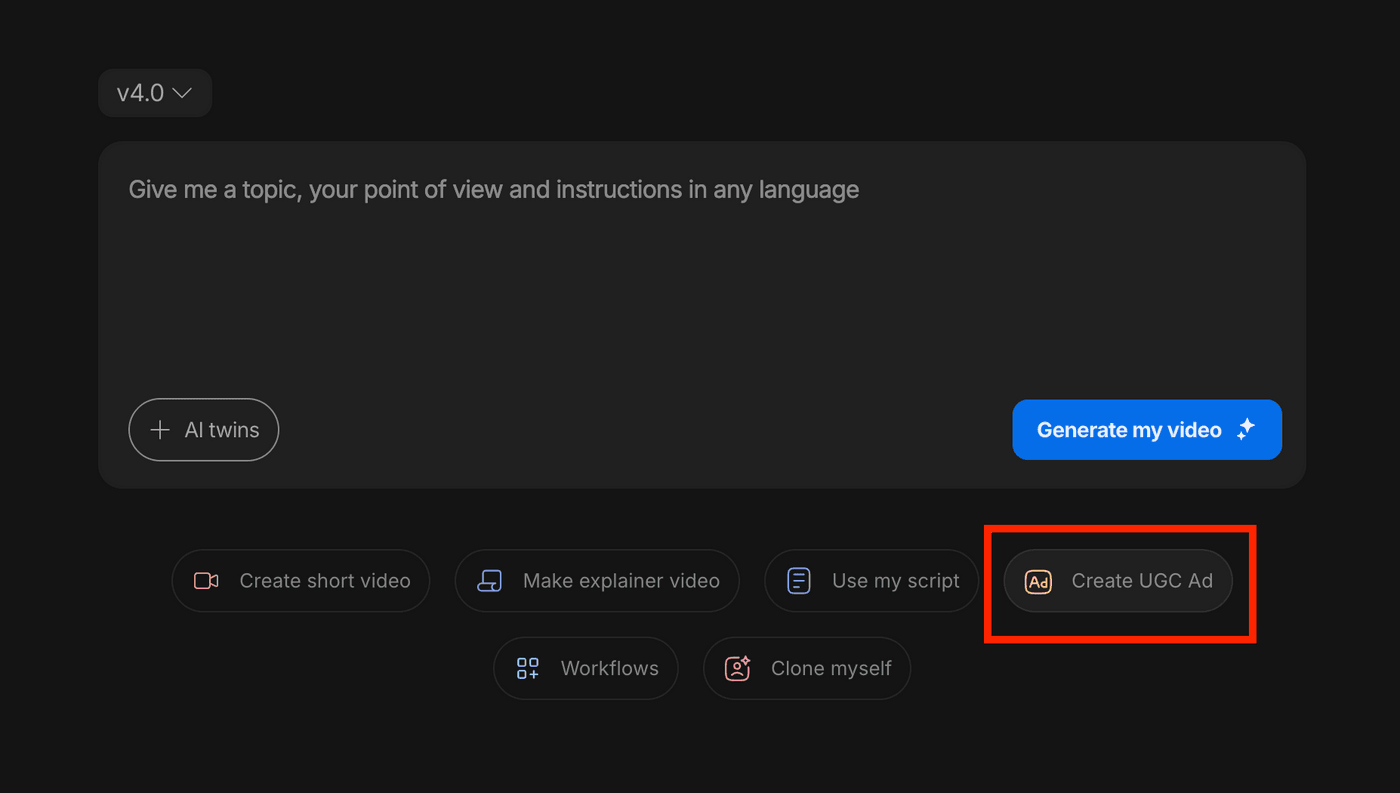
Start by logging into your invideo AI account. If you're new to the platform, create an account using your email and set up your password. Once you're in the dashboard, locate and click on "Create UGC ad" to begin the process.
Step 2: Select Your AI Actor
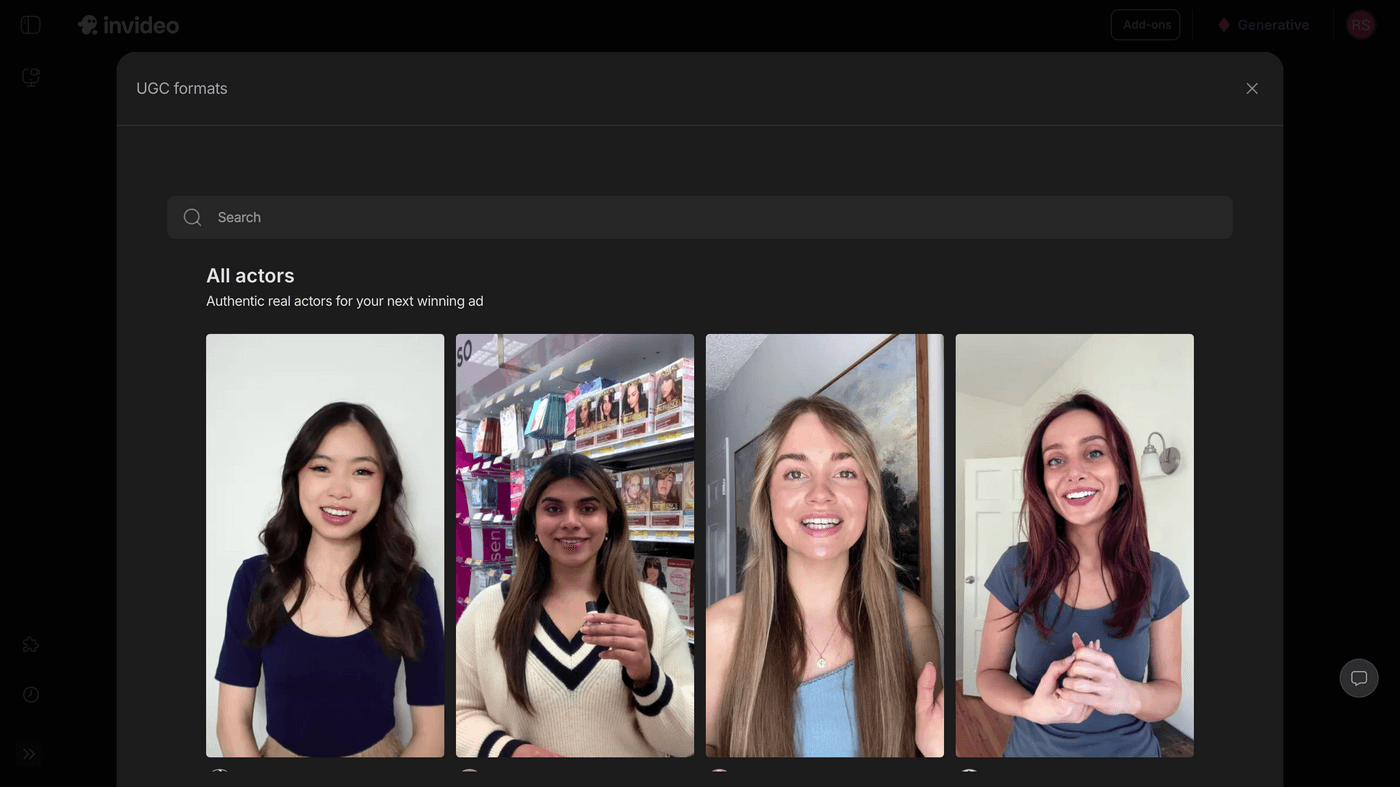
Choose an actor by browsing available options. Invideo AI offers a diverse library of real human avatars based on different gender, age range, location, or other demographics to match your target audience. Pick an actor that best represents your ideal customer.
Step 3: Add Product Information
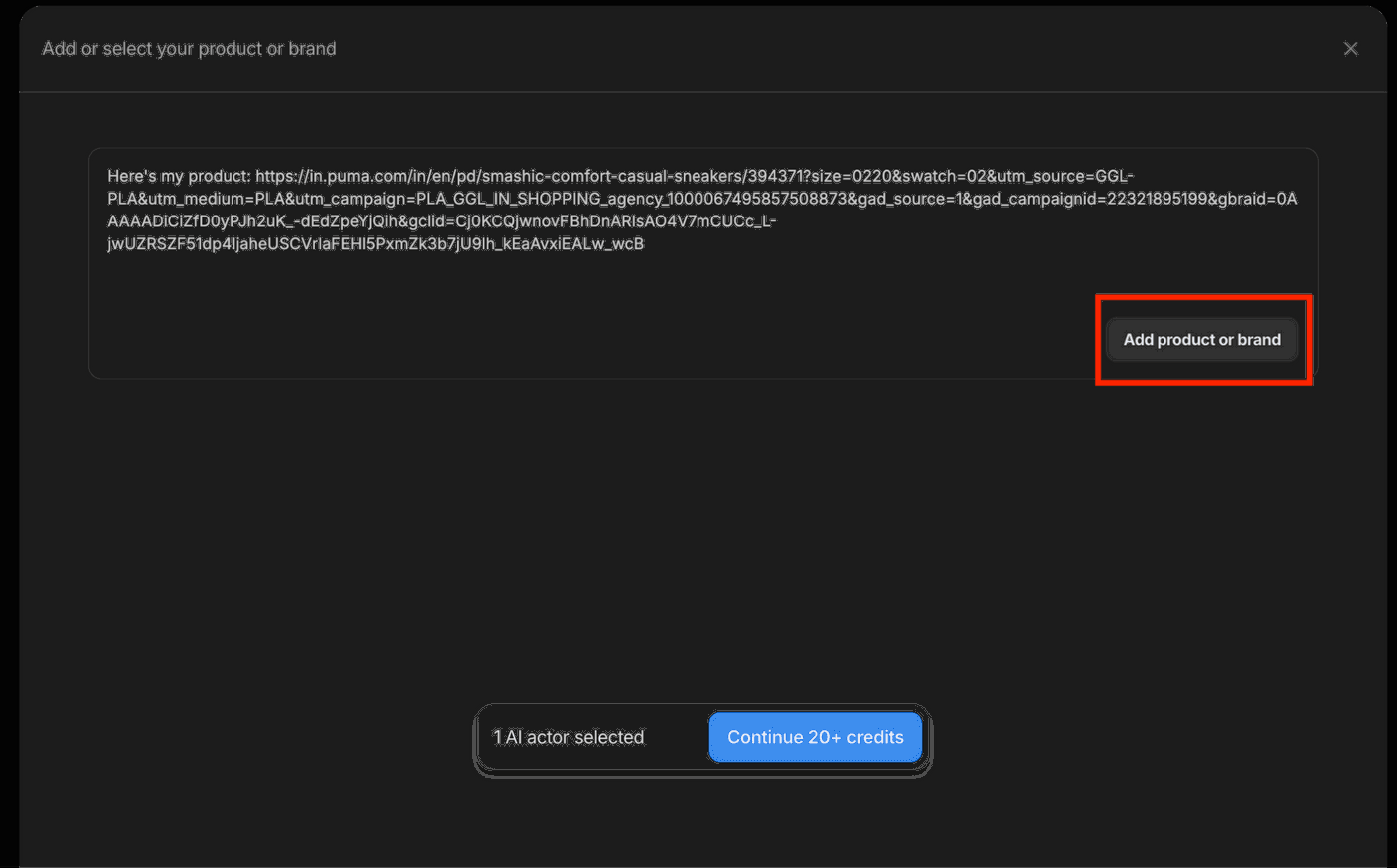
Click "Add product or brand" to input details about what you're promoting. You have two options here: manually enter product information or simply paste your product or brand URL. The AI will automatically extract relevant details from the link, making the process faster and more accurate.
Step 4: Customize Video Settings
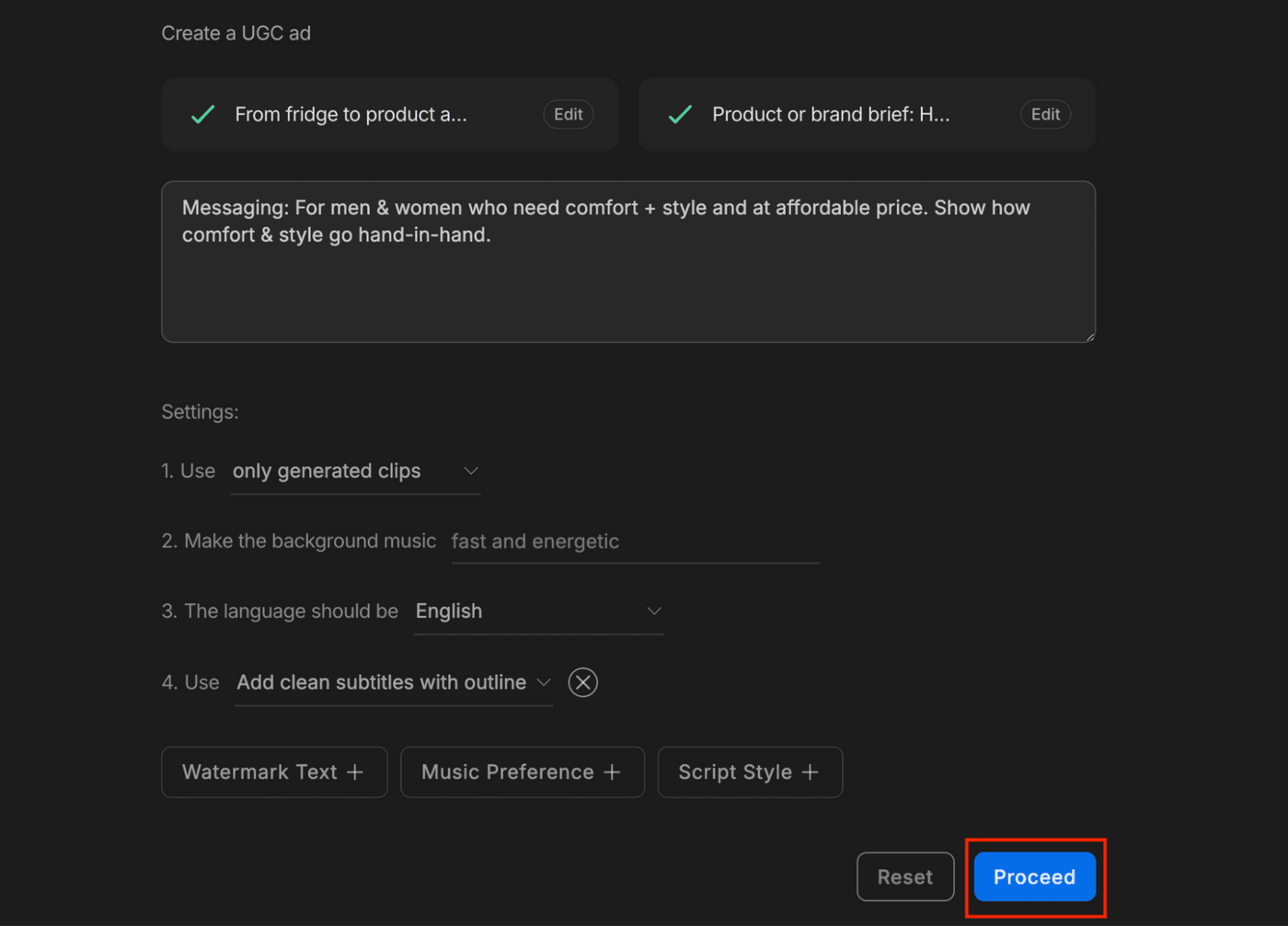
Define your vision or what kind of video you’re looking for, including details about your audience. And, before generating your content, adjust the technical settings to match your needs:
- Select background music that fits your brand
- Choose your preferred language for the video
- Decide on watermark preferences
- Configure subtitle options for accessibility
- Set audio preferences
Once you've configured everything, click "Proceed" to move forward.
Step 5: Review and Generate
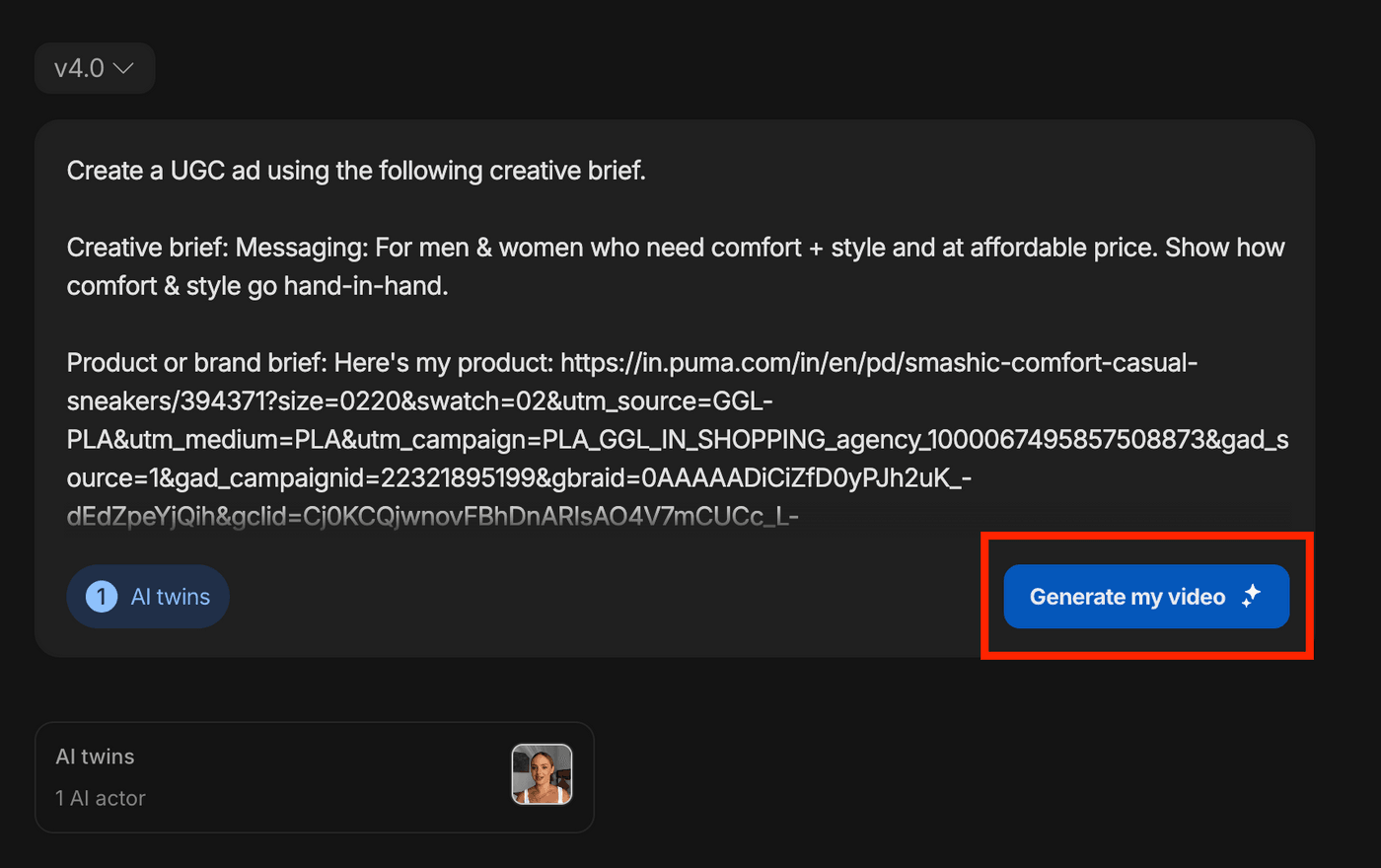
The platform will display your complete prompt, showing all the selections you've made. Review this carefully to ensure everything aligns with your vision. When you're satisfied, click "Generate my video" to start the creation process.
Step 6: Choose Your Content Style
After a brief processing period, invideo AI will present three distinct options:
- Generative Ultra UGC: Premium UGC-style content with enhanced quality and realism
- Generative UGC: Standard AI-generated content featuring real human actors delivering your message
- Stock Media UGC: UGC-style content incorporating high-quality stock footage
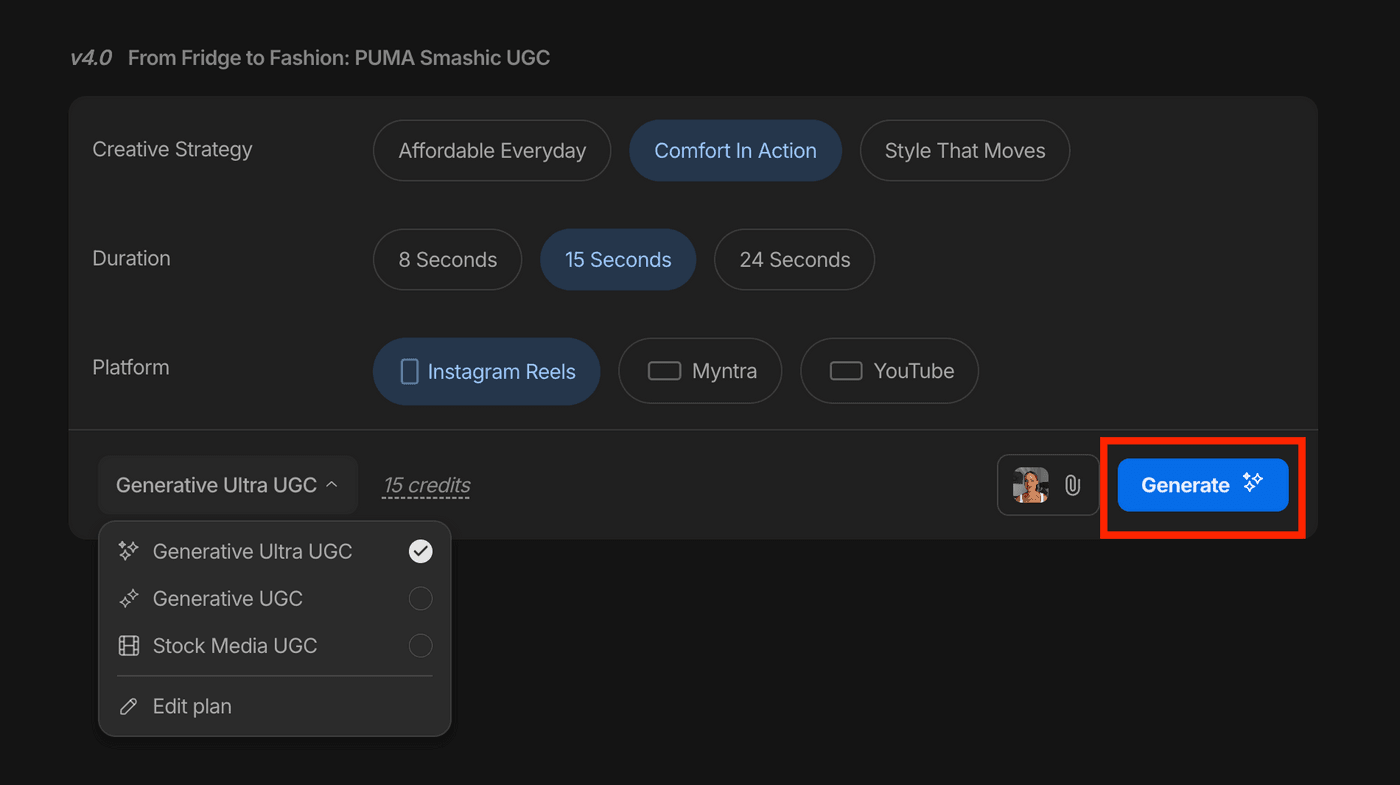
You can also make any needed changes to this plan or your given prompt by clicking on ‘Edit Plan’. Otherwise, click "Generate" to proceed with video generation.
Step 7: Final Processing and Download
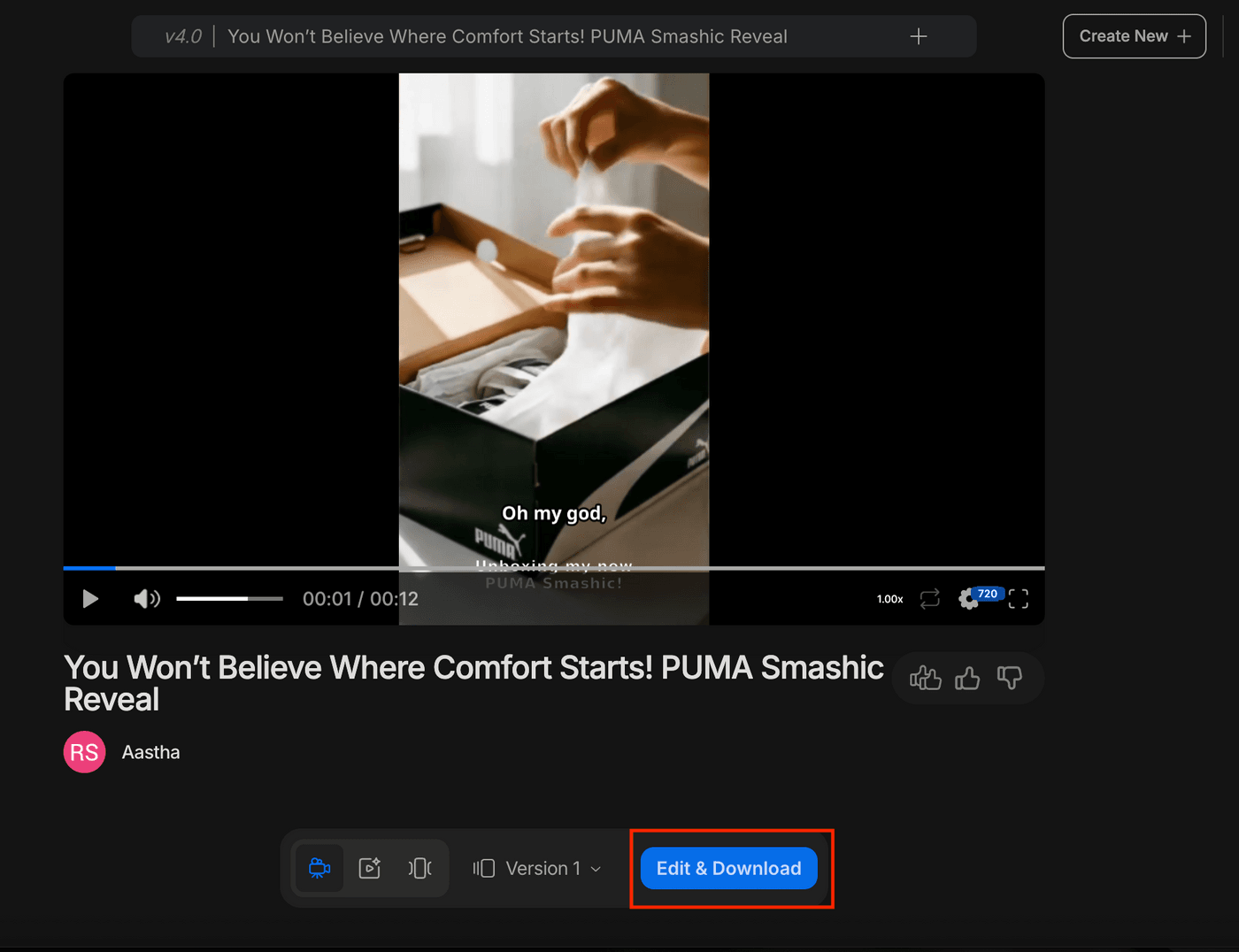
Allow the platform a few moments to process your final video. Once complete, you'll see your finished UGC-style content. If you want to make any adjustments, simply type your modifications in the magic box (editing prompt box) provided. When you're happy with the result, click "Download" to save the video to your device.
The entire process takes just minutes, giving you professional UGC-style content that you can use across all your marketing channels immediately.
Common UGC Mistakes (And How to Avoid Them)
Even successful brands make these UGC mistakes that kill authenticity and waste resources:
-
Legal Issues: Rights, Permissions, and Usage Agreements
Using customer content without permission creates legal risks and damages relationships. Always ask permission before reposting, clearly communicate usage terms, and maintain proper documentation. With AI-generated UGC, ensure your platform provides full commercial usage rights.
-
Brand Consistency vs Authentic Variety
Over-controlling UGC messaging kills authenticity. The best UGC maintains your core brand values while allowing individual expression. Don't script every word—provide guidelines and let authenticity shine through.
-
Over-Curating Content and Losing Authenticity
Showing only perfect customer experiences makes your UGC feel fake. Include diverse perspectives, honest opinions, and real customer challenges. Authenticity includes imperfections.
Lush Cosmetics does this well - they share UGC that shows everything from perfect application to messy experimentation with their products. The variety feels genuine and relatable.
-
Platform Mismatches: Wrong Content for Wrong Audience
LinkedIn UGC should feel professional, while TikTok UGC should feel native and trendy. Don't use the same content across platforms without adapting tone, length, and style.
-
Neglecting Content Creators and Community Building
Whether working with human creators or building customer communities, relationships matter. Acknowledge contributors, provide fair compensation, and build long-term partnerships rather than transactional interactions.
-
Measuring Vanity Metrics Instead of Business Impact
Likes and views don't pay bills. Focus on metrics that matter: conversion rates, cost per acquisition, customer lifetime value, and actual revenue generated from UGC campaigns.
Getting Started with UGC in 2025
Ready to build your UGC content machine? Here's your roadmap:
Audit Your Current Content and Identify UGC Opportunities
Look at your existing customer communications—reviews, support tickets, social mentions, and feedback. What positive experiences could become UGC content? What questions do customers ask repeatedly that UGC could answer?
Choose Your Approach: Traditional Community Building vs Modern AI-Assisted Creation
Decide whether you want to build long-term customer relationships through community-driven UGC or need immediate content for testing and scaling. Most successful brands use both approaches strategically.
Set Up Measurement Systems for Tracking Success
Define what success looks like before you start. Is it increased sales, lower acquisition costs, higher engagement, or brand awareness? Set up tracking systems to measure UGC impact on these goals.
Start Small: Test, Learn, and Scale What Works
Begin with one platform and one type of UGC content. Test different approaches, measure results, and scale successful formats. Don't try to be everywhere at once—focus on what works for your audience.
Budget Considerations and Resource Allocation
Traditional UGC requires time and community building. Paid UGC creators cost $50-500 per video. AI UGC tools start around $25-200 per month for unlimited content. Choose based on your timeline, budget, and quality requirements.
The Testing Framework
-
Create 3 different content variations
-
Test on same audience simultaneously
-
Measure performance after 48-72 hours
-
Scale the winner with additional variations
-
Iterate based on performance data
Ready to Get Started?
Creating viral UGC doesn't require massive budgets or months of planning anymore. Pick a tool that fits your budget and goals, then start small. Test 2-3 video variations, see what clicks with your audience, and scale the winners.
The best content still comes down to hooks that stop the scroll and messages that connect. AI just makes it faster and cheaper to test your ideas.
Start with one platform, nail your first viral video, then expand from there.
Frequently Asked Content Strategy Questions:
What are AI UGC tools and do they work?
AI UGC tools use artificial intelligence to create authentic-looking user-generated content with virtual actors. Yes, they work—brands report similar performance to traditional UGC with faster production times and lower costs.
What platforms work best for UGC campaigns?
TikTok and Instagram lead for visual UGC, YouTube works for longer testimonials, and LinkedIn excels for B2B UGC. Choose platforms where your audience naturally shares experiences and discoveries.
How do I maintain brand consistency with AI user-generated content?
Provide clear brand guidelines covering tone, key messages, and visual style. AI tools can maintain consistency while allowing natural variation in delivery and presentation style.
Legal and Practical Questions:
Do I need permission to repost customer content?
Yes, always ask permission before reposting customer content. Most customers are happy to give permission, especially when you credit them properly. Develop a simple permission process to streamline requests.
How do I handle negative UGC or reviews?
Address negative feedback professionally and publicly when possible. Negative UGC, when handled well, can actually build trust by showing transparency. Don't hide from criticism—use it to improve and demonstrate customer service.
What's the difference between UGC creators and customers?
Customers create content organically because they love your product. UGC creators are professionals who create authentic-looking content for brands. Both provide value, but serve different purposes in your content strategy.
Performance and ROI Questions:
How do I measure UGC success?
Track metrics that impact your business: conversion rates, cost per acquisition, customer lifetime value, and revenue attribution. Engagement metrics matter too, but connect them to business outcomes for meaningful measurement.
Why does UGC perform better than branded content?
UGC leverages social proof, feels more trustworthy, and directly addresses customer concerns through peer perspectives. It provides authentic validation that branded content can't match, leading to higher conversion rates.
How quickly can I expect results from UGC campaigns?
Traditional UGC building takes 3-6 months to gain momentum. Paid UGC creators deliver results in 1-2 weeks. AI UGC tools provide immediate content for testing, with optimized campaigns showing results within days of launch.


